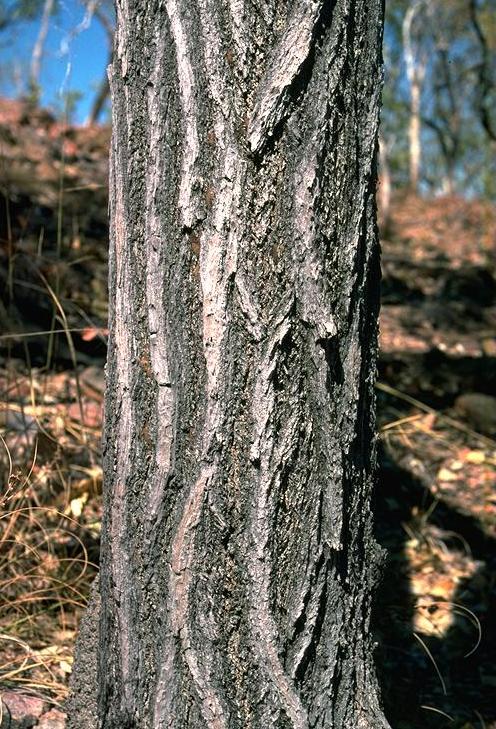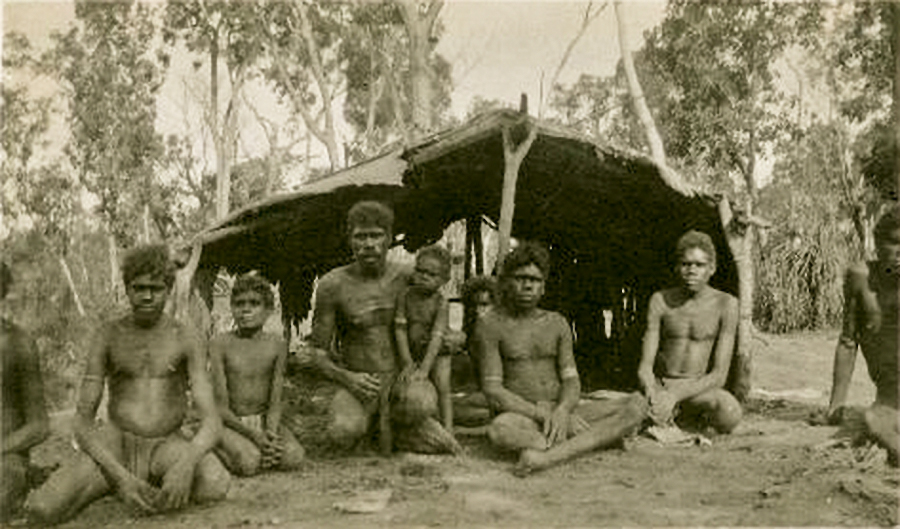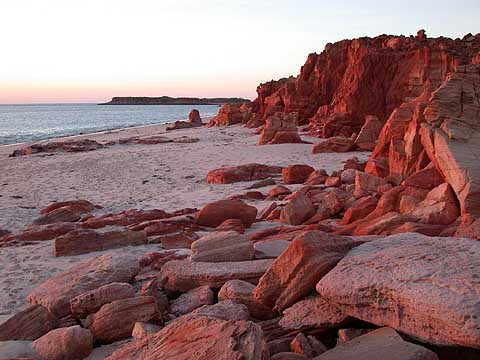|
Eucalyptus Jensenii
''Eucalyptus jensenii'', commonly known as Wandi ironbark, is a species of tree that is endemic to northern Australia. It has hard, coarse black "ironbark", egg-shaped to lance-shaped adult leaves, flower buds in groups of seven, creamy white flowers and barrel-shaped to conical fruit. Description ''Eucalyptus jensenii'' is a tree that typically grows to a height of and forms a lignotuber. It has hard, rough, coarse black "ironbark" on the trunk and larger branches. Young plants and coppice regrowth have dull greyish green, egg-shaped to elliptic leaves long and wide. Adult leaves are the same shade of dull green or greyish green on both sides, egg-shaped to lance-shaped, long and wide on a petiole long. The flower buds are arranged mostly on the ends of branchlets on a branching peduncle long. Each branch of the peduncle has seven buds, each bud on a pedicel long. Mature buds are pear-shaped to oval, long and wide with a conical operculum. Flowering occurs from Janua ... [...More Info...] [...Related Items...] OR: [Wikipedia] [Google] [Baidu] |
Gibb River
The Gibb River is a river in the Kimberley (Western Australia), Kimberley region of northern Western Australia. The headwaters of the river rise between the Caroline and Gibb Ranges. The river flows in a northerly direction until merging with the Drysdale River, of which it is a tributary. Gibb River has three tributaries: North Creek, Plain Creek and Russ Creek. The Gibb River was named in 1901 by the surveyor Charles Crossland during an expedition in the Kimberley area. It is named after geologist Andrew Gibb Maitland, who had accompanied Crossland and was present during the first recorded sighting of the river. In turn, it gives its name to the Gibb River Road, a former cattle route that stretches almost 660 kilometres (410 mi) across the Kimberley between the towns of Derby, Western Australia, Derby and the Kununurra, Western Australia, Kununurra and Wyndham, Western Australia, Wyndham junction of the Great Northern Highway. The traditional owners of the area that th ... [...More Info...] [...Related Items...] OR: [Wikipedia] [Google] [Baidu] |
Harald Jensen (geologist)
Harald Ingemann Jensen (12 June 1879 – 13 July 1966) was an Australian geologist, academic, public servant and political candidate. He was born in Denmark and came to Australia as a young child. Early life Harald Jensen was born in 1879 in Aarhus, Jutland to farmer Niels Georg Oscar Jensen and Clara (''née'' Nielsen), the latter of whom was purported to be a descendant of the great Danish poet Bernhard Severin Ingemann. Around 1885 the family migrated to Queensland, where young Harald attended public schools before winning a scholarship to Brisbane Boys' Grammar School. In 1898, Jensen was employed at Clement Wragge's observatory at Mount Kosciuszko before briefly studying at the University of Sydney; he took time off from 1900 to 1901 to teach in Sydney and North Queensland before returning to his studies in 1902, receiving a Bachelor of Science specialising in geology in 1904. He was employed as an assistant demonstrator to Edgeworth David before becoming the first Maclea ... [...More Info...] [...Related Items...] OR: [Wikipedia] [Google] [Baidu] |
Myrtales Of Australia
The Myrtales are an order of flowering plants placed as a sister to the eurosids II clade as of the publishing of the ''Eucalyptus grandis'' genome in June 2014. The APG III system of classification for angiosperms still places it within the eurosids. This finding is corroborated by the placement of the Myrtales in the Malvid clade by the One Thousand Plant Transcriptomes Initiative. The following families are included as of APGIII: * Alzateaceae S. A. Graham * Combretaceae R. Br. ( leadwood family) * Crypteroniaceae A. DC. * Lythraceae J. St.-Hil. ( loosestrife and pomegranate family) * Melastomataceae Juss. (including Memecylaceae DC.) * Myrtaceae Juss. (myrtle family; including Heteropyxidaceae Engl. & Gilg, Psiloxylaceae Croizat) * Onagraceae Juss. (evening primrose and Fuchsia family) * Penaeaceae Sweet ex Guill. (including Oliniaceae Arn., Rhynchocalycaceae L. A. S. Johnson & B. G. Briggs) * Vochysiaceae A. St.-Hil. The Cronquist system gives essentially the same co ... [...More Info...] [...Related Items...] OR: [Wikipedia] [Google] [Baidu] |
Eucalyptus
''Eucalyptus'' () is a genus of over seven hundred species of flowering trees, shrubs or mallees in the myrtle family, Myrtaceae. Along with several other genera in the tribe Eucalypteae, including '' Corymbia'', they are commonly known as eucalypts. Plants in the genus ''Eucalyptus'' have bark that is either smooth, fibrous, hard or stringy, leaves with oil glands, and sepals and petals that are fused to form a "cap" or operculum over the stamens. The fruit is a woody capsule commonly referred to as a "gumnut". Most species of ''Eucalyptus'' are native to Australia, and every state and territory has representative species. About three-quarters of Australian forests are eucalypt forests. Wildfire is a feature of the Australian landscape and many eucalypt species are adapted to fire, and resprout after fire or have seeds which survive fire. A few species are native to islands north of Australia and a smaller number are only found outside the continent. Eucalypts have been grow ... [...More Info...] [...Related Items...] OR: [Wikipedia] [Google] [Baidu] |
Trees Of Australia
The flora of Australia comprises a vast assemblage of plant species estimated to over 30,000 vascular and 14,000 non-vascular plants, 250,000 species of fungi and over 3,000 lichens. The flora has strong affinities with the flora of Gondwana, and below the family level has a highly endemic angiosperm flora whose diversity was shaped by the effects of continental drift and climate change since the Cretaceous. Prominent features of the Australian flora are adaptations to aridity and fire which include scleromorphy and serotiny. These adaptations are common in species from the large and well-known families Proteaceae (''Banksia''), Myrtaceae (''Eucalyptus'' - gum trees), and Fabaceae ('' Acacia'' - wattle). The arrival of humans around 50,000 years ago and the settlement by Europeans from 1788, has had a significant impact on the flora. The use of fire-stick farming by Aboriginal people led to significant changes in the distribution of plant species over time, and the ... [...More Info...] [...Related Items...] OR: [Wikipedia] [Google] [Baidu] |
Eucalypts Of Western Australia
Eucalypt is a descriptive name for woody plants with capsule fruiting bodies belonging to seven closely related genera (of the tribe Eucalypteae) found across Australasia: ''Eucalyptus'', ''Corymbia'', '' Angophora'', ''Stockwellia'', ''Allosyncarpia'', ''Eucalyptopsis'' and ''Arillastrum''. Taxonomy For an example of changing historical perspectives, in 1991, largely genetic evidence indicated that some prominent ''Eucalyptus'' species were actually more closely related to ''Angophora'' than to other eucalypts; they were accordingly split off into the new genus ''Corymbia''. Although separate, all of these genera and their species are allied and it remains the standard to refer to the members of all seven genera ''Angophora'', ''Corymbia'', ''Eucalyptus'', ''Stockwellia'', ''Allosyncarpia'', ''Eucalyptopsis'' and ''Arillastrum'' as "eucalypts" or as the eucalypt group. The extant genera ''Stockwellia'', ''Allosyncarpia'', ''Eucalyptopsis'' and ''Arillastrum'' comprise six kn ... [...More Info...] [...Related Items...] OR: [Wikipedia] [Google] [Baidu] |
List Of Eucalyptus Species
The following is an alphabetical list of ''Eucalyptus'' species accepted by the Australian Plant Census as at February 2019. Several species only occurring outside Australia, including '' E. orophila'', '' E. urophylla'' and '' E. wetarensis'' are listed at the World Checklist of Selected Plant Families. A * '' Eucalyptus abdita'' Brooker & Hopper * '' Eucalyptus absita'' Grayling & Brooker – Badgingarra box * '' Eucalyptus acaciiformis'' H.Deane & Maiden – wattle-leaved peppermint * '' Eucalyptus accedens'' W.Fitzg. – powderbark wandoo * '' Eucalyptus acies'' Brooker – Woolburnup mallee * '' Eucalyptus acmenoides'' Schauer in W.G.Walpers – white mahogany * ''Eucalyptus acroleuca'' L.A.S.Johnson & K.D.Hill – Lakefield coolibah * '' Eucalyptus adesmophloia'' (Brooker & Hopper) D.Nicolle & M.E.French * '' Eucalyptus aequioperta'' Brooker & Hopper – Welcome Hill gum * ''Eucalyptus agglomerata'' Maiden – blue-leaved stringybark * ''Eucalyptus aggregata'' H.Deane & ... [...More Info...] [...Related Items...] OR: [Wikipedia] [Google] [Baidu] |
Groote Eylandt
Groote Eylandt ( Anindilyakwa: ''Ayangkidarrba'' meaning "island" ) is the largest island in the Gulf of Carpentaria and the fourth largest island in Australia. It was named by the explorer Abel Tasman in 1644 and is Dutch for "Large Island" in archaic spelling. The modern Dutch spelling is ''Groot Eiland''. The original inhabitants of Groote Eylandt are the Anindilyakwa, an Aboriginal Australian people, who speak the Anindilyakwa language (also known as Amamalya Ayakwa). They consist of 14 clan groups which make up the two moieties on the island. The clans maintain their traditions and have strong ties with the people in the community of Numbulwar and on Bickerton Island. The island's population was 2,811 in the 2016 census. There are four communities on Groote Eylandt. The mining company GEMCO established the township of Alyangula for its workers. The three main Aboriginal communities are Angurugu and Umbakumba, and Milyakburra on Bickerton Island. There are also a number ... [...More Info...] [...Related Items...] OR: [Wikipedia] [Google] [Baidu] |
Dampier Peninsula
The Dampier Peninsula is a peninsula located north of Broome and Roebuck Bay in Western Australia. It is surrounded by the Indian Ocean to the west and north, and King Sound to the east. It is named after the mariner and explorer William Dampier who visited it. The northernmost part of the peninsula is Cape Leveque. It is sparsely inhabited, mostly by Indigenous Australian peoples, some of whom have been granted native title rights to some of their traditional lands. There are many coastal inlets, bays and other features, including Beagle Bay on its western side. Aboriginal heritage The peninsula is home to a rich heritage of Aboriginal culture, with the communities of Beagle Bay, Bobieding, Djarindjin, Ardyaloon (One Arm Point) and Ngardalargin, along with numerous other smaller communities, pearling camps, tourist resorts and Aboriginal outstations. The traditional owners of the areas around the peninsula are the Bardi, Nyunyul and Jabirr Jabirr (Djaberadjabera) peo ... [...More Info...] [...Related Items...] OR: [Wikipedia] [Google] [Baidu] |
Kimberley, Western Australia
The Kimberley is the northernmost of the nine regions of Western Australia. It is bordered on the west by the Indian Ocean, on the north by the Timor Sea, on the south by the Great Sandy and Tanami deserts in the region of the Pilbara, and on the east by the Northern Territory. The region was named in 1879 by government surveyor Alexander Forrest after Secretary of State for the Colonies John Wodehouse, 1st Earl of Kimberley. History The Kimberley was one of the earliest settled parts of Australia, with the first humans landing about 65,000 years ago. They created a complex culture that developed over thousands of years. Yam ('' Dioscorea hastifolia'') agriculture was developed, and rock art suggests that this was where some of the earliest boomerangs were invented. The worship of Wandjina deities was most common in this region, and a complex theology dealing with the transmigration of souls was part of the local people's religious philosophy. In 1837, with expedition ... [...More Info...] [...Related Items...] OR: [Wikipedia] [Google] [Baidu] |
Type (biology)
In biology, a type is a particular specimen (or in some cases a group of specimens) of an organism to which the scientific name of that organism is formally attached. In other words, a type is an example that serves to anchor or centralizes the defining features of that particular taxon. In older usage (pre-1900 in botany), a type was a taxon rather than a specimen. A taxon is a scientifically named grouping of organisms with other like organisms, a set that includes some organisms and excludes others, based on a detailed published description (for example a species description) and on the provision of type material, which is usually available to scientists for examination in a major museum research collection, or similar institution. Type specimen According to a precise set of rules laid down in the International Code of Zoological Nomenclature (ICZN) and the International Code of Nomenclature for algae, fungi, and plants (ICN), the scientific name of every taxon is almost al ... [...More Info...] [...Related Items...] OR: [Wikipedia] [Google] [Baidu] |
Botanical Name
A botanical name is a formal scientific name conforming to the '' International Code of Nomenclature for algae, fungi, and plants'' (ICN) and, if it concerns a plant cultigen, the additional cultivar or Group epithets must conform to the ''International Code of Nomenclature for Cultivated Plants'' (ICNCP). The code of nomenclature covers "all organisms traditionally treated as algae, fungi, or plants, whether fossil or non-fossil, including blue-green algae ( Cyanobacteria), chytrids, oomycetes, slime moulds and photosynthetic protists with their taxonomically related non-photosynthetic groups (but excluding Microsporidia)." The purpose of a formal name is to have a single name that is accepted and used worldwide for a particular plant or plant group. For example, the botanical name ''Bellis perennis'' denotes a plant species which is native to most of the countries of Europe and the Middle East, where it has accumulated various names in many languages. Later, the plant was intro ... [...More Info...] [...Related Items...] OR: [Wikipedia] [Google] [Baidu] |







.jpg)
.jpg)